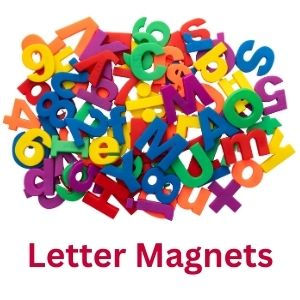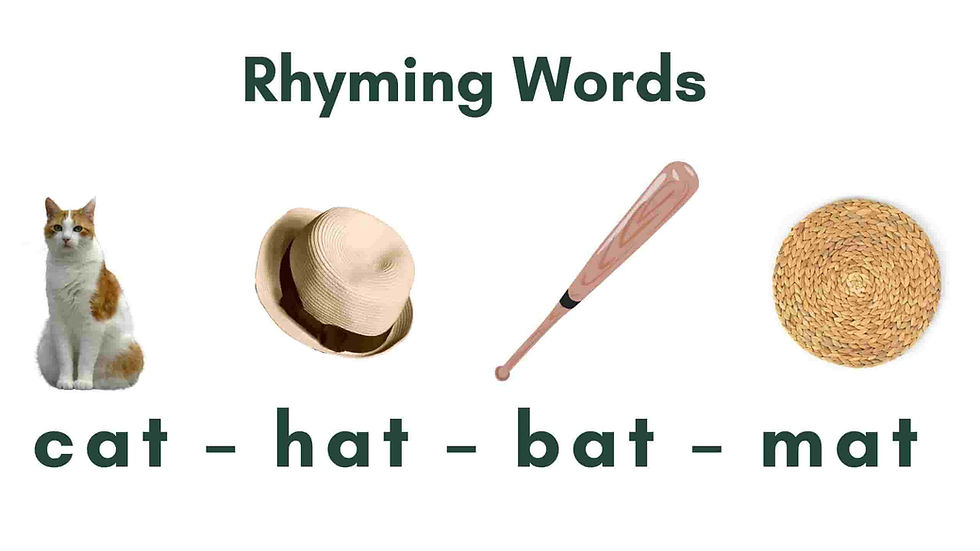Letter Magnets: Kindergarten Curriculum
- Aria Dana

- Aug 14
- 8 min read
Updated: Sep 10
The Fun, Hands-On Way to Boost Early Reading Skills

Did you know that a set of colorful letter magnets can do more for your child's reading skills than hours of memorization?
For kindergarteners, learning letters isn't just about seeing them on paper—it's about touching, moving, and playing with them. That's exactly why letter magnets are a favorite in both classrooms and homes.
Why Letter Magnets Work for Kindergarten Literacy
In early literacy, multi-sensory learning is key. Letter magnets:
Engage multiple senses – Children see the letter, touch it, and physically place it somewhere
Reinforce letter-sound connections – As they move a letter, they can say its name and sound
Make spelling playful – Kids experiment with forming words without the pressure of handwriting
Encourage independent learning – A magnetic board or fridge becomes their personal "writing desk"
💡 When learning feels like a game, children stay motivated longer and retain information better.
How to Use Letter Magnets at Home
Name Recognition Game – Spell your child's name and mix up the letters; have them rearrange them in order
Sound Match – Say a letter sound and ask your child to find the matching magnet
Word Building Challenge – Start with short words like cat, dog, or sun
Story Starter – Give your child 3 letters and let them make up a silly story with words that start with those letters
Products you may try:
Educational Insights Color-Coded Lowercase AlphaMagnets 🔗
A set of 42 plastic lowercase magnetic letters, color-coded with red vowels and blue consonants. Includes extra vowels and commonly used consonants.
Melissa & Doug 52 Wooden Alphabet Magnets in a Box 🔗
A set of 52 wooden magnetic letters in both uppercase and lowercase. Comes in a sturdy wooden box for storage. Designed for letter recognition, spelling, and creativity. Made with FSC-certified materials for responsible sourcing.
Coogam Wooden Magnetic Fishing Game 🔗
A wooden alphabet fishing set with 26 letter-shaped fish, 2 magnetic poles, and a wooden sorting box. Helps kids learn letters and colors while improving fine motor skills and hand-eye coordination.
Melissa & Doug See & Spell Wooden Educational Toy 🔗
Includes 8 double-sided wooden puzzle boards and 64 wooden letters for matching words to pictures. Designed for ages 4+, it helps build sight-reading vocabulary, spelling, and fine motor skills.
LeapFrog Fridge Phonics Magnetic Letter Set 🔗
Includes a magnetic tile reader and 26 interactive letter tiles. Each tile teaches letter names, sounds, and vocabulary through songs and spoken examples. Skills developed include phonics, alphabet recognition, fine motor skills, and vocabulary. Tiles can be placed on the reader to hear letters, words, and sentences.
Coogam Magnetic Letters Numbers Alphabet Fridge Magnets (78 Pcs) 🔗
A 78-piece set including 26 uppercase letters, 26 lowercase letters, 20 numbers, and 6 math symbols in five colors.
Wooden Magnetic Alphabet Maze Letter Puzzle 🔗
A Montessori-inspired wooden maze board with 26 magnetic, car-shaped letter blocks. Children use a magnetic pen to guide each letter to its matching parking spot, improving fine motor skills, hand-eye coordination, concentration, and letter recognition. With a strong magnet pen connected by a string.
Large Size Magnetic Letters, Cute Animal Alphabet ABC Magnets 🔗
A set of 26 large magnetic uppercase letters, each paired with a vivid animal illustration to aid letter and animal recognition.
Magnetic Wooden Fishing Game Toy for Toddlers 🔗
A wooden fishing game puzzle with colorful fish pieces featuring letters and numbers. Includes a magnetic fishing pole to catch the pieces, promoting letter and number recognition, color identification, hand-eye coordination, and fine motor skills.
Coogam Magnetic Letters Numbers Alphabet Fridge Magnets 🔗
A 135-piece educational set with 78 wooden letters (2 lowercase sets, 1 uppercase set), 20 numbers, 7 math symbols, 5 weather icons, and 30 double-sided flashcards. Includes full-back magnets for secure attachment to metal surfaces.
“There is no ‘best’ method in teaching; the best is the one that works for your child.”
References
Adeyemi, O.A., et al. (2025). Effect of Gamification in ICT-Based Learning Platforms on Motivation and Retention in Reading Comprehension for Children with Dyslexia in Mainstream Basic Schools with Inclusive Education in Kaduna State, Nigeria. African Journal of Education Research and Leadership Practice, 4(1).
Ahmad, N.A., et al. (2023). A Case Study on the Use of Play-based Learning in a Malaysian Preschool. International Journal of Academic Research in Progressive Education and Development, 12(3).
Apostolidou, E., et al. (2018). Traditional games in elementary school: Relationships of student's personality traits, motivation and experience with learning outcomes. PLOS ONE, 13(8).
Bahrick, L.E., et al. (2021). Multisensory integration and maternal sensitivity are related to each other and predictive of expressive vocabulary in 24-month-olds. Developmental Psychology, 57(10).
Banda, C., et al. (2024). Bringing Learning to Life: Essential Factors of Play-Based Learning at Home – A Case Study of Mazabuka, Zambia. International Journal of Research and Innovation in Social Science, 8(8).
Barutchu, A., et al. (2017). Audio-Visual Perception of Gender by Infants Emerges Earlier for Adult-Directed Speech. Developmental Psychology, 53(1).
Boets, B., et al. (2016). The unique role of lexical accessibility in predicting kindergarten emergent literacy. Applied Psycholinguistics, 37(2).
Brockman, R., et al. (2011). Children's active play: self-reported motivators, barriers and facilitators. BMC Public Health, 11.
Bunce, J., et al. (2016). The Multisensory Nature of Verbal Discourse in Parent–Toddler Interactions. Child Development, 87(4).
Caballo, J.T.T., et al. (2025). Enhancing Kindergarten Letter Recognition Through Play-Based Learning. International Journal of Innovative Science and Research Technology.
Chen, Y.C., et al. (2015). Examining young children's perception toward augmented reality-infused dramatic play. Educational Technology Research and Development, 63(3).
Codding, R.S., et al. (2020). Evaluating the Effects of Instructional Prompts and Strategic Incremental Rehearsal on the Letter Identification Mastery of Two Typically Developing Kindergarteners. Behavior Analysis in Practice, 13(3).
Georgiou, G.K., et al. (2022). The Association Between Emergent Literacy and Cognitive Abilities in Kindergarten Children. Child & Youth Care Forum, 51(4).
Gultom, I.S., et al. (2024). Boosting Early Reading Skills with Alphabet Puzzle Media: The Effectiveness of Positive Reinforcement. Psikostudia Jurnal Psikologi, 13(2).
Hansen, K.G., et al. (2023). The significance of children's olfactory experiences in a Norwegian kindergarten: an olfactory researcher-practitioner collaboration. European Early Childhood Education Research Journal, 31(4).
Hansen, M.R., et al. (2023). The learning early childhood education and care institution as an inclusion arena. European Early Childhood Education Research Journal, 31(5).
James, K.H. (2013). Brain activation patterns resulting from learning letter forms through active self-production and passive observation in young children. Developmental Science, 16(4).
Justice, L.M., et al. (2020). Latent Class Growth Trajectories of Letter Name Knowledge During Pre-Kindergarten and Kindergarten. Applied Psychology, 69(3).
Kray, J., et al. (2014). Dissociable effects of game elements on motivation and cognition in a task-switching training in middle childhood. Frontiers in Psychology, 5.
Lee, S.M., et al. (2024). Play-Based Learning With Games as a Dance Teaching Tool. Harmonia: Journal of Arts Research and Education, 24(1).
Lewkowicz, D.J. (2015). Multisensory Integration and Child Neurodevelopment. Child Development Perspectives, 9(1).
Lin, C.H., et al. (2024). The Application of Arts Integration Technology for Online Learning in Early Childhood Education. IEEE Access, 12.
Liquin, E.G., et al. (2024). Exploration in 4‐year‐old children is guided by learning progress and novelty. Developmental Science, 27(6).
Lonigan, C.J., et al. (2016). Bidirectional relations between phonological awareness and letter knowledge in preschool revisited: A growth curve analysis of the relation between two code-related skills. Journal of Experimental Child Psychology, 144.
Lonigan, C.J., et al. (2021). Integrating Literacy and Science Instruction in Kindergarten: Results From the Efficacy Study of Zoology One. School Psychology Review, 50(3).
Masek, L.R., et al. (2022). Can guidance during play enhance children's learning and development in educational contexts? A systematic review and meta‐analysis. Child Development, 93(4).
Mthembu, N., et al. (2023). Impact of play-based learning on the development of children in mobile early childhood care and education centres. International Journal of Research in Business and Social Science, 12(2).
Murray, M.M., et al. (2020). Multisensory Gains in Simple Detection Predict Global Cognition in Schoolchildren. Developmental Psychology, 56(2).
Nguyen, T.H. (2024). Approaching Multi-Sensory Education Methods for Preschool Children. International Journal of Management Research and Review, 7(9).
Olsson, L.M., et al. (2023). A Systematic Review of Curiosity and Wonder in Natural Science and Early Childhood Education Research. Journal of Research in Childhood Education, 37(3).
Perry, L.K., et al. (2023). Touch to learn: Multisensory input supports word learning and processing. Developmental Science, 26(4).
Phillips, L.M., et al. (2022). Prediction of kindergarten and first-grade reading skills: unique contributions of preschool writing and early-literacy skills. Reading and Writing, 35(11).
Piasta, S.B., et al. (2018). Acquisition of Letter Naming Knowledge, Phonological Awareness, and Spelling Knowledge of Kindergarten Children at Risk for Learning to Read. Child Development Research.
Proyer, R.T., et al. (2018). How Playfulness Motivates – Putative Looping Effects of Autonomy and Surprise Revealed by Micro-Phenomenological Investigations. Frontiers in Psychology, 9.
Quiros, L.F., et al. (2025). The magic of multi-sensorial learning: Enhancing the letter formation among kindergarten through rainbow writing. Davao Research Journal, 16(1).
Rahman, S.A., et al. (2024). Incorporating Play-Based Learning into the Curriculum for Preschools in Malaysia: Challenges and Practical Recommendations. International Journal of Research and Innovation in Social Science, 8(7).
Roemmich, J.N., et al. (2012). Autonomy supportive environments and mastery as basic factors to motivate physical activity in children: a controlled laboratory study. International Journal of Behavioral Nutrition and Physical Activity, 9.
Saputra, S., et al. (2024). Learning with Letter Cards in Literacy Introduction for Children Aged 4-5 Years at Taman Firdaus Islamic Kindergarten Karanganyar. Proceedings of the 7th International Seminar on Education Technology.
Sari, D.P., et al. (2024). Whole Brain Teaching and Multi-Sensory Environments on Cognitive Science Development: Moderated by Children's Learning Preferences. International Journal of Research in Education and Research, 2(4).
Sari, N.P., et al. (2025). Utilizing Monopoly Game Media to Enhance Students' Motivation Acquisition about the Fulfillment of Balanced Nutrition. International Journal of Global Health Science and Research, 2(1).
Sharma, R., et al. (2024). The Role of Play-Based Learning in Enhancing Cognitive and Emotional Development in Early Childhood. International Journal for Multidisciplinary Research, 6(6).
Simatupang, D., et al. (2024). Application of Picture Alphabet Calendar Media (KALFABER) Towards Literacy Skills of 4-5 Year Old Children in Kindergarten Bina Harapanku. Maspul Journal of Community Service Research, 5(2).
Singh, A., et al. (2025). Enhancing Early Childhood Education Environments: A Delphi Survey On The Influence Of Interior Design Elements For Children With Mobility Impairments. International Journal of English and Studies, 7(6).
Sinaga, N., et al. (2025). Improving the Literacy Ability of Children Aged 5-6 Years Through Letter Flow Maze Media. Jurnal PG-PAUD Trunojoyo, 10(1).
Smith, J.A. (2019). Multi-Sensory Technology In Teaching English To Young Learners. World Journal of English Language, 9(2).
Tadlas, M.D., et al. (2024). Utilizing Eduball in Enhancing Pre-Literacy Skills Among Kindergarten Learners. RSI International.
Thompson, A., et al. (2024). Play-Based and Nature Learning: Optimal Approaches for Children on the Autism Spectrum. International Journal for Multidisciplinary Research, 6(5).
Thompson, K.L., et al. (2024). Multisensory stimulation for promoting development and preventing morbidity in preterm infants. Cochrane Database of Systematic Reviews, 7.
Tortella, P., et al. (2023). Acceptability and effectiveness of the "Education in Action—ABALL1" intervention program in primary school-aged children. Frontiers in Psychology, 14.
Treiman, R., et al. (2007). Which children benefit from letter names in learning letter sounds? Cognition, 106(3).
Usman, N., et al. (2023). Improving Literacy Skills through Letter Ball Games for Children 5-6 Years Old. Indonesian Journal of Early Childhood Education, 5(1).
Vinci-Booher, S., et al. (2020). Motor-Enriched Encoding Can Improve Children's Early Letter Recognition. Frontiers in Psychology, 11.
Wang, L., et al. (2023). Exploring the role of learning through play in promoting multimodal learning among children: a pilot study in Chinese first-tier cities. Frontiers in Psychology, 14.
Wijaya, A., et al. (2023). Tahfiz Al-Qur'an Learning Management of Integrated Islamic Early Childhood Education. International Journal of Social Science and Human Research, 6(12).
Woods, R., et al. (2013). Posture support improves object individuation in infants. Infant Behavior and Development, 36(3).
Zosh, J.M., et al. (2019). Play-Based Learning: Evidence-Based Research to Improve Children's Learning Experiences in the Kindergarten Classroom. Early Childhood Research Quarterly, 49.
Last updated: Sunday, August 31, 2025, 10:09 PM, Eastern Time (ET)
.jpg)



























































Comments